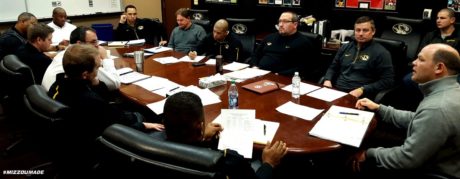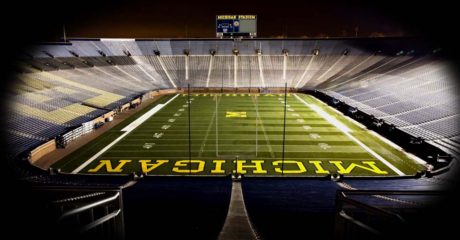
Thanks to Ashley, Moser, Roy, and Stephen for the Paypal donations! If you would like to make a donation, please use the Paypal button the sidebar or here:
For previous posts in this series, click here (part 1) or here (part 2).
Having addressed the similarities between Tyrone Wheatley and Jay Harbaugh on distributing carries and then the reasons for rotating running backs, here’s the final piece on how a coaching staff might handle the weekly rotation.
Hit the jump for more.
RECONNAISSANCE
Scouting a team starts weeks ahead of the actual game, with analysts and coaches reviewing film. Football programs also have their own analytics guys or pay outside companies to provide them with analytics. For run game purposes, they can tell the coaching staff which play concepts, personnel packages, play directions, etc. might be most successful against a certain team. For example, some teams might give up 8.5 yards/carry on outside zone, so Michigan might want to focus on outside zone that week. Which running back runs outside zone best? Or maybe a team allows just 20% of passes to be completed that are thrown 15+ yards down the field, so Michigan may want to focus on the short passing game and really shore up its pass protection for a rare deep shot. Which running back is the best pass protector? Some defenses run a ton of man coverage and are difficult to run screens against, so maybe the best screen guy gets put on the shelf for a week.
STAFF MEETINGS
Coaches meet constantly during the week. Of course, there are stories about some coaches spending the night at the office, just sleeping on a couch or a cot. But the game plan that develops is shared among the coaching staff. That week’s focus on power or pin and pull or inside zone will be shared with everyone on the offensive staff. Furthermore, the offensive coordinator and other offensive coaches will collaborate on personnel packages, formations, motions, etc. A coordinator is in charge of coordinating his own ideas with those of his offensive staff. The coordinator might have an idea for a trick play, the running backs coach might have an idea for a two-back formation to stress the opponent’s base defense, the tight end coach might have an idea for a motion or RPO, the offensive line coach might suggest a certain adjustment on inside zone blocking, and the quarterbacks coach might notice something with coverage or cornerback leverage. The running backs coach makes suggestions or recommendations about which of his running backs should play on certain plays or in certain schemes. Ultimately, again, it’s the coordinator’s job to take all of those ideas, pick and choose what can be accomplished during the week, and then mold them into a game plan.
THE GAME PLAN
Any football fan knows that offensive coordinators hold or look down at their play sheets during the game. I won’t get into what might be on those play sheets, but those play sheets are usually set by the first day of practice for that week. So as an example, the play sheet for the Rutgers game would be shared with the entire staff by Monday. The rest of the coaches had input, but the coordinator (or head coach) has the final say about what ends up on the play sheet. From that point forward, it’s the position coach’s job to implement the coordinator’s game plan. I don’t know how Michigan works its offensive practices, but Monday might be an inside zone day, Tuesday might be power, Wednesday might be pin and pull, Thursday might be outside zone, and Friday is probably a walkthrough/review. There are various ways to work through this during the week (down and distance, personnel groupings, schemes, etc.). The coordinator and running backs coach (along with the rest of the staff) will meet daily to review how practice went, who’s doing what well, who’s struggling, who’s dinged up, etc. As the week goes along, the play sheet might change a little bit based on which plays the QB is comfortable running, any injuries that might change a call, etc., but in general, the play sheet will largely remain the same from Monday.
GAME DAY
A lot of coaches say game day should be the easiest day of the week, and that goes for coaches, too (in my opinion). You’re not coaching up all 8 of your running backs on game day, doing drill work, giving tips, etc. You’re focused on the 3-4 guys who are getting on the field. Offensive coordinators typically think a couple plays ahead, so their first down call sets up their third down call. Or their first down call sets up their next first down call. As the offensive coordinator says the personnel package and play call into the head set, the running backs coach repeats the package aloud (“11” or “Ninja”) or sends his running back onto the field by name (“Haskins, go for Corum”). Maybe Blake Corum is in the “Cheetah” package but got dinged up, so Chris Evans is next in for “Cheetah.” The offensive coordinator isn’t responsible for making substitutions because he has too much on his plate, but the running backs coach’s job is to implement the game plan that was agreed upon throughout the week. If this week is a heavy inside zone week and Haskins is the best inside zone runner, then it would be Jay Harbaugh’s job to insert Haskins for all inside zone packages. If it’s 3rd-and-9, then it would be Jay Harbaugh’s job to insert Zach Charbonnet since he’s the best pass protector.
An opening game script determined by the offensive coordinator might go something like this:
1. 11 personnel (1 RB, 1 TE), inside zone: Haskins
2. 11 personnel (1 RB, 1 TE), inside zone play action: Haskins
3. 10 personnel (1 RB, 0 TE), sprint out pass: Charbonnet
4. 12 personnel (1 RB, 2 TE), power: Charbonnet
5. 21 personnel (2 RB, 1 TE), play action RB wheel: Haskins, Corum
Etc.
(If a coach scripts his opening plays, it will usually be 10-20 plays, but you get the point.)
TAKEAWAYS
This series ended up being a little longer than what I intended, and hopefully you stuck around for all three parts. So here’s a summary of the series, which was developed partially in response to the gaggle of people wanting Jay Harbaugh fired because of the running back rotation and blaming him for Michigan’s failures:
- Jay Harbaugh, despite not having played the game at a high level, does not have a history of messing with the running back rotation any more than Tyrone Wheatley, who was an amateur superstar, 1st round draft pick, NFL veteran, and now a veteran coach at both the collegiate and NFL levels.
- Running back substitutions are dependent on much more than “He’s the fastest” or “He runs the best” or “He’s the biggest.” There are various things that go into game planning, including the skill sets and efficiency of certain running backs in certain schemes.
- The game plan is developed in the weeks and days before the game based on film, analytics, etc. Running back rotations are determined not on the field on game day, but in meetings during the week where the running backs coach, the offensive coordinator, and (potentially) the head coach all have input into which players should play, how often they should rotate, and how multiple their offense will be.
You need to login in order to vote


You must belogged in to post a comment.